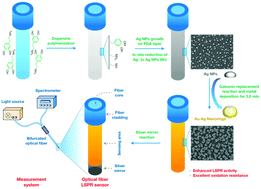In situ growth of Au–Ag bimetallic nanorings on optical fibers for enhanced plasmonic sensing†
Abstract
Highly functionalized materials at the nanoscale on optical fibers offer notable opportunities to construct “lab-on-fiber” functional devices with unusual properties. However, it is extremely difficult to fabricate nanostructures with special morphology on a thin cylindrical optical fiber surface using the commonly used physical lithography techniques. Meanwhile, it is vital to maintain the plasmonic properties of Ag-riched particles while improving their stability. Herein, we design a facile strategy for the fabrication of Au–Ag bimetallic nanorings (Au–Ag NRs) immobilized on optical fibers for enhanced plasmonic properties. Ag NPs are first grown in situ on an optical fiber surface through chelation and redox of polydopamine (PDA) to metal ions, and then are quickly converted into Au–Ag NRs by a galvanic replacement reaction and metal deposition. This conversion only takes 3.5 min, while the formed Au–Ag NRs exhibit outstanding localized surface plasmon resonance (LSPR) sensitivity (2204 nm per RIU) and oxidation resistance, and Au and Ag atoms are distributed uniformly in the nanorings. Furthermore, a novel and interesting formation process of the nanorings including deformation, spallation, growth in the gaps, and ring formation is studied. These findings provide a way to grow bimetallic nanorings on optical fibers, which are promising candidates for photoelectric “lab-on-fiber” devices.



 Please wait while we load your content...
Please wait while we load your content...